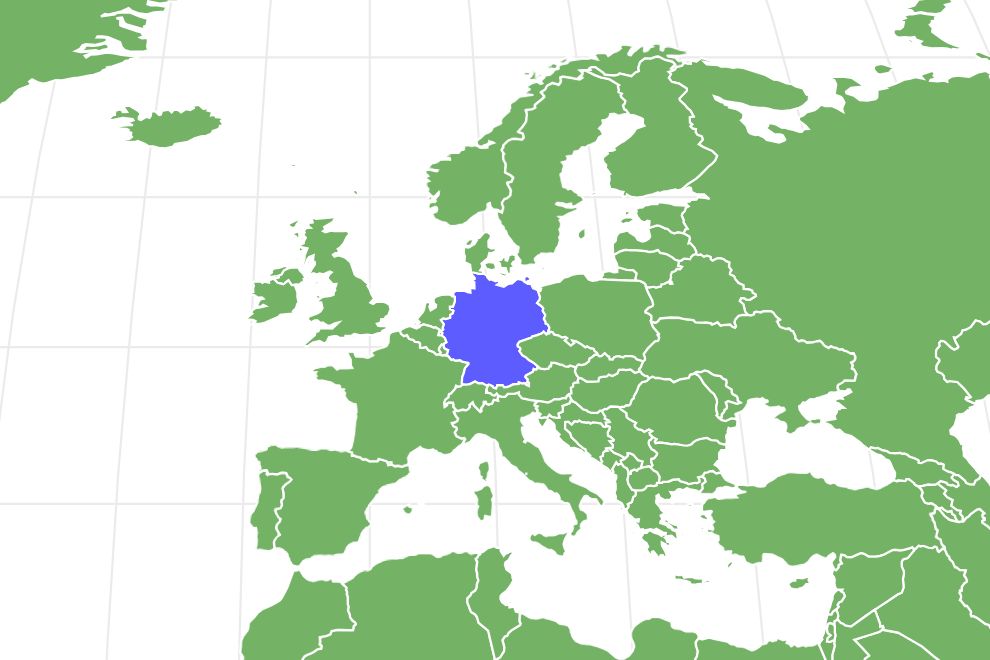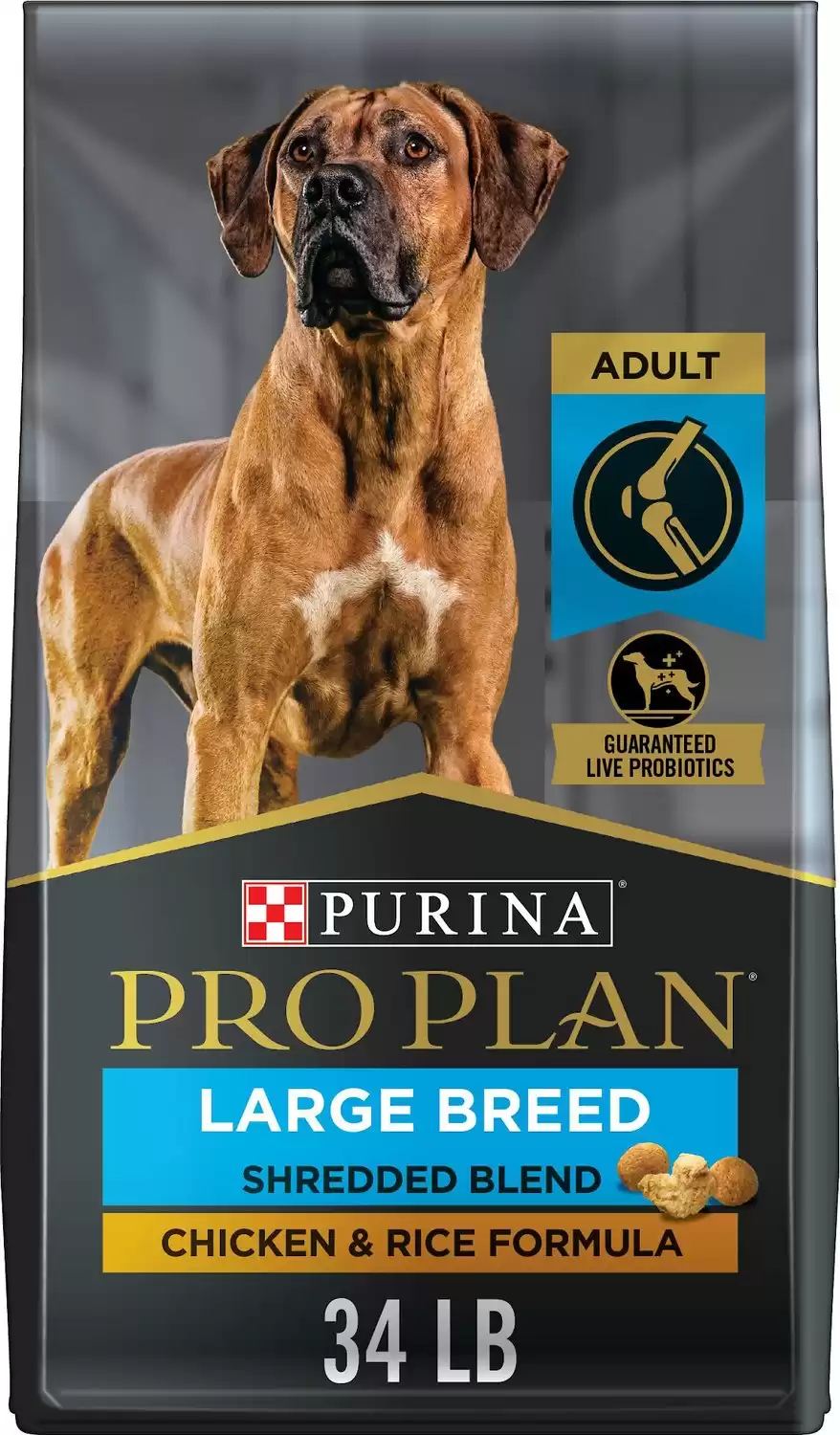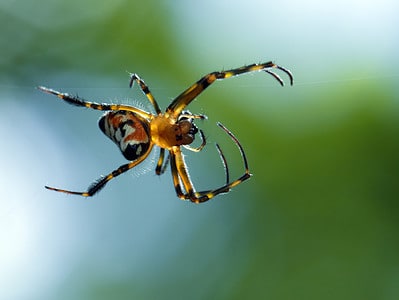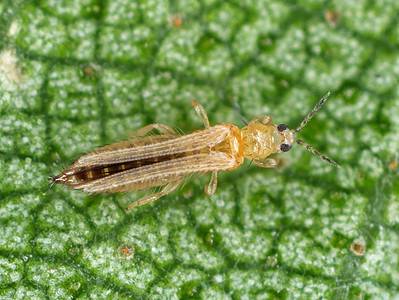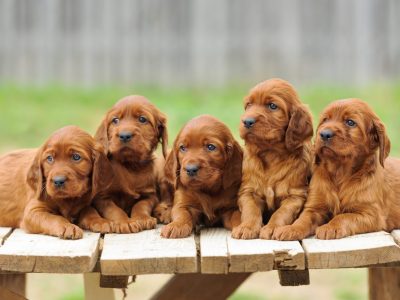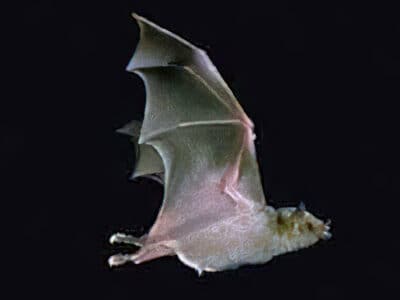Giant Schnauzer
Canis lupus
Large, powerful and dominant!
Advertisement
Giant Schnauzer Scientific Classification
- Kingdom
- Animalia
- Phylum
- Chordata
- Class
- Mammalia
- Order
- Carnivora
- Family
- Canidae
- Genus
- Canis
- Scientific Name
- Canis lupus
Read our Complete Guide to Classification of Animals.
Giant Schnauzer Conservation Status
Giant Schnauzer Facts
Giant Schnauzer as a Pet:
- General Health
- Energy Level
- Shedability
- Trainability
- Intelligence
- Tendency to Chew
- Size
- Family and kid friendliness
- Yappiness / Barking
- High
- Hypoallergenic
- Yes
- Separation Anxiety
- Moderate
- Preferred Temperature
- Average climate
- Exercise Needs
- High
- Friendly With Other Dogs
- Moderate
- Pure bred cost to own
- $1,000 - $1,500
- Dog group
- Sporting
- Male weight
- 60-85 lbs
- Female weight
- 55-75 lbs
This post may contain affiliate links to our partners like Chewy, Amazon, and others. Purchasing through these helps us further the A-Z Animals mission to educate about the world's species.
View all of the Giant Schnauzer images!
Giant Schnauzers originated from the Bavarian Alps somewhere around the mid-1800s. They were bred from a standard Schnauzer to be a working dogs to herd cattle from a farm to the market.
Giant Schnauzers are a very large breed of dog that is black in color. They have a very loyal and protective temperament and can make a good family dog for families with older children. They are also a hypoallergenic breed as their dense and wiry coats do not shed very much.
See all of our expert product reviews.
History and Origin
Coming from Bavaria in the 19th century, this breed developed from crossbreeding standard schnauzers and Great Danes to produce a larger, more robust dog. Giant Schnauzers were used as guard dogs, primarily for innkeepers, farmers, or merchants, and also they were used by police and the military. Later, once railroads were built and made it unnecessary for the Giant Schnauzers to herd the cattle, the breed worked alongside the police and military in Europe. It wasn’t until the 1920s that they were brought to America.
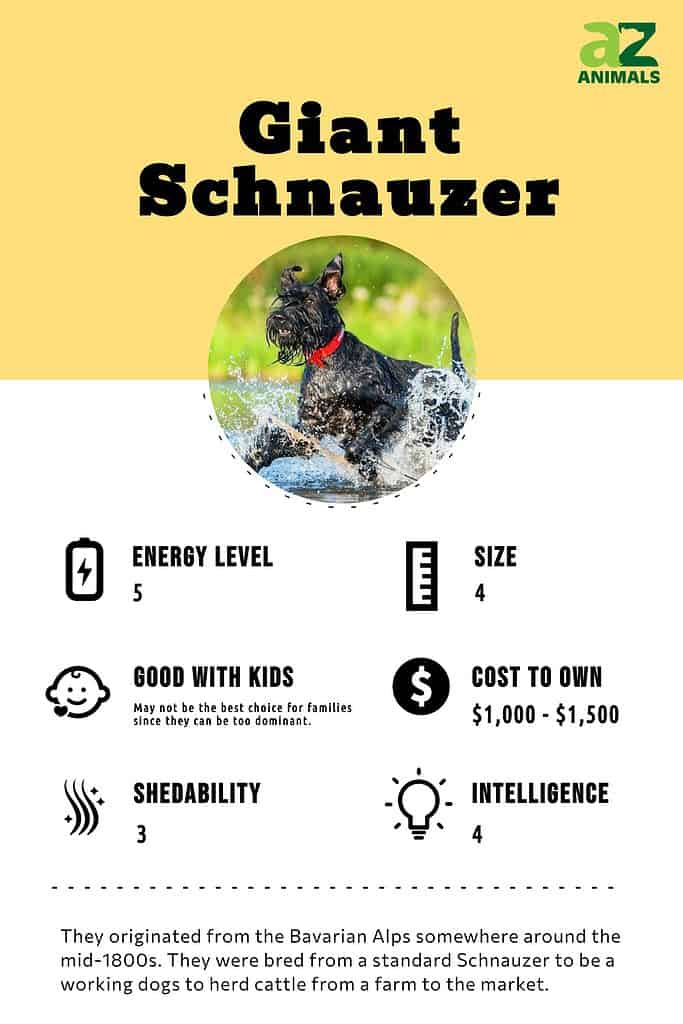
Ownership: 3 Pros and Cons
| Pros! | Cons! |
|---|---|
| Loyal: Giant Schnauzers are very loyal to their owners and families. | Can be aggressive: Some Giant Schnauzers may become aggressive if they feel threatened or think something is threatening their owners. |
| Hypoallergenic: Giant Schnauzers do not shed much and are a good choice for homes where a family member suffers from allergies. | Not good for young children: Giant Schnauzers are not ideal for homes with younger children as they may act too dominant. |
| Easy to train: Giant Schnauzers are intelligent and easier to train than some other dog breeds. | Can become destructive: If a Giant Schnauzer does not receive enough physical or mental exercise, it can become destructive. |
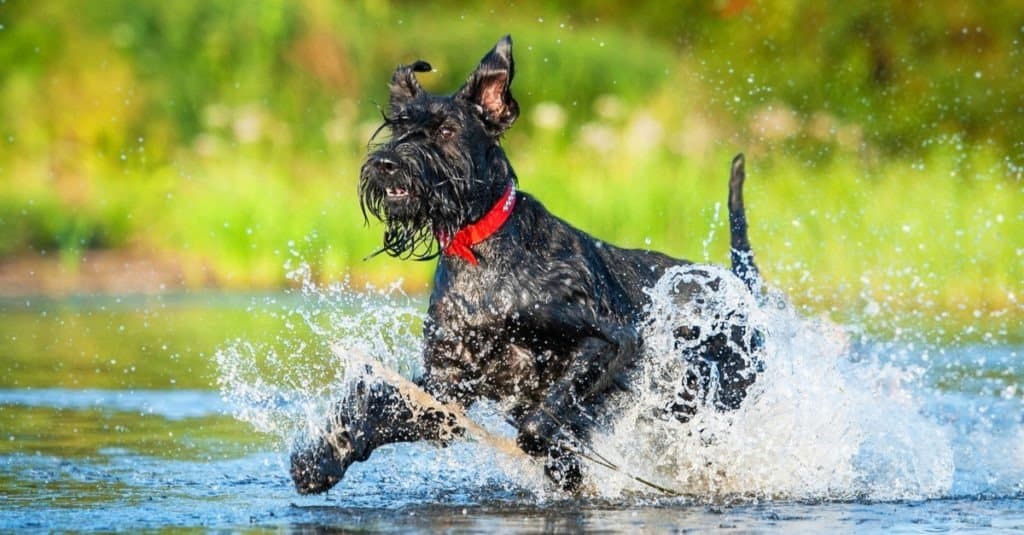
Giant Schnauzers are intelligent and easier to train than some other dog breeds.
©Rita_Kochmarjova/Shutterstock.com
Size and Weight
Giant Schnauzers are very large dogs. Males can weigh between 60 and 85 pounds and are between 25.5 and 27.5 inches tall. Females typically weigh between 55 and 75 pounds and are between 23.5 and 25.5 inches tall. When puppies are three months old, they generally weigh between 21 and 37 pounds. Six-month-old puppies weigh between 39 and 68 pounds. Giant Schnauzers finish growing between the ages of 16 and 19 months.
| Height (Male) | 25.5 inches to 27.5 inches |
| Height (Female) | 23.5 inches to 25.5 inches |
| Weight (Male) | 60 pounds to 85 pounds |
| Weight (Female) | 55 pounds to 75 pounds |
Learn more about the best big dog breeds here.
Health and Entertainment for your Giant Schnauzer
See all of our expert product reviews.
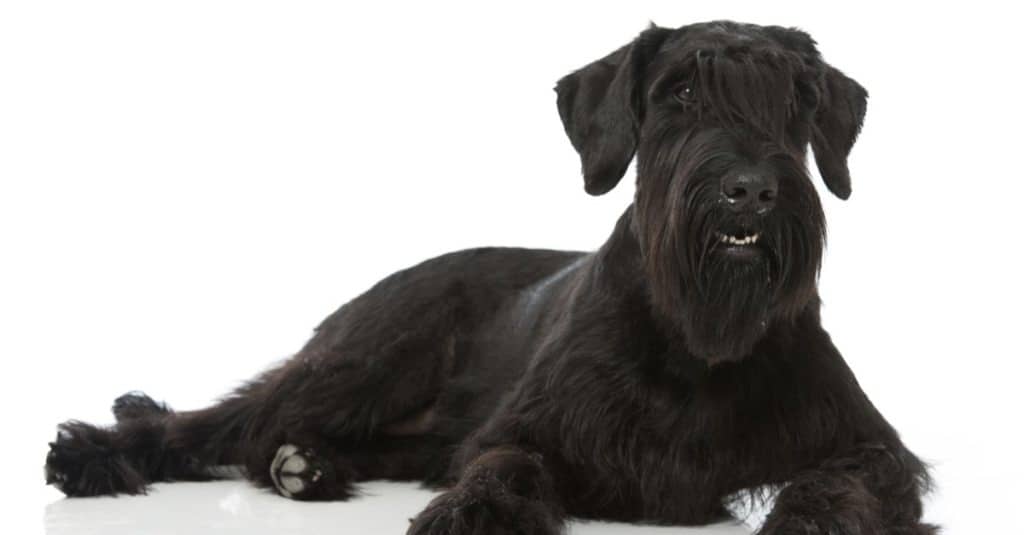
Male Giant Schnauzers can weigh between 60 and 85 pounds and are between 25.5 and 27.5 inches tall. Females typically weigh between 55 and 75 pounds and are between 23.5 and 25.5 inches tall.
©Dora Zett/Shutterstock.com
Different Types
Giant Schnauzers have a distinctive look, but their coats do come with slight variations. You can find them in three different looks: Pure Black, Salt and Pepper, and Black Undercoat.
This being the “giant” version of the Schnauzer, it is good to note that they are very similar to their smaller relatives the Standard Schnauzer and the Mini Schnauzer. The look and temperament are similar, and the main difference is, as you may have guessed overall size.
Common Health Issues
There are a few common health issues to be aware of before you bring home a Giant Schnauzer. While all dogs in this breed will not necessarily develop all, or even any, of these issues, knowing what to look out for can help make sure you catch health problems as early as possible.
Dental disease is one potential issue that Giant Schnauzers may suffer from. Dental disease begins with tartar buildup, which if not properly cleaned can cause damage to the teeth or even organs.
Giant Schnauzers may also suffer from viral or bacterial infections. These include rabies, parvo, and distemper. Since many of these can be prevented with a vaccine, it is very important to make sure you stick with the recommended vaccination schedule for your Giant Schnauzer.
Obesity is another health concern for Giant Schnauzers. When Giant Schnauzers suffer from obesity, it can lead to heart disease, digestive disorders, back pain, and other potentially serious issues. Make sure you are feeding your dog the recommended amount of food and giving him or her enough exercise to prevent obesity from becoming a problem.
To review, some common health issues Giant Schnauzers may face include:
- Dental disease
- Bacterial and viral infections
- Obesity
Temperament and Behavior
Giant Schnauzers have a relatively quiet temperament. This breed is very loyal to their family and those they trust, but they can be suspicious of new people or places. In most cases, Giant Schnauzers are more laid back, but some exhibit aggressive traits when feeling threatened.
Giant Schnauzers were bred to be working dogs, so they also have a more alert personality. Because of their breeding, they’re also used to more mental stimulation and may become bored easily, which can lead to destructive behaviors. Giant Schnauzers can also make a good family dog and can generally be trusted around older children.
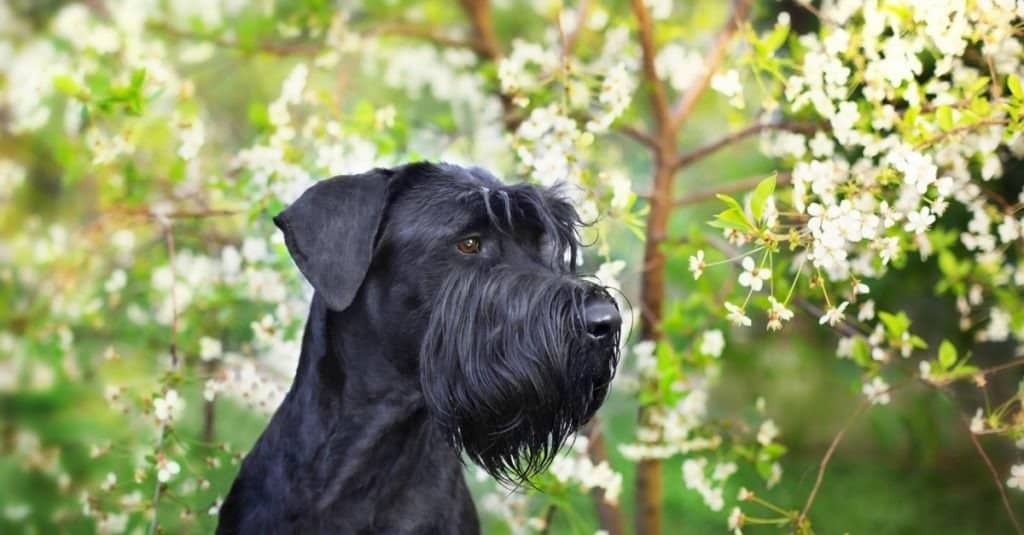
This breed is very loyal to their family and those they trust, but they can be suspicious of new people or places.
©Kwadrat/Shutterstock.com
How to Take Care of One
Each dog breed is unique, and Giant Schnauzers and no exception. As you prepare to care for a Giant Schnauzer, it is important to keep their temperament, health concerns, dietary needs, and other factors in mind.
The Best Dog Food
Giant Schnauzers should be fed high-quality large-breed dog food. Some Giant Schnauzers who are overweight could benefit from a weight control formula. In general, Giant Schnauzers need between 3 3/8 and 4 ¼ cups of food each day. This food should be split into two services. The exact amount of food that is right for your Giant Schnauzer can vary based on age, weight, activity level, health concerns, and other factors, so check with your veterinarian if you are unsure how much food he or she should eat.
Schnauzer puppies should eat puppy food designed for large-breed puppies. Puppies have smaller stomachs and will need to eat smaller meals more frequently throughout the day. When puppies are between eight and 12 weeks old, they should be fed four meals a day, and puppies between three and six months old should be fed three meals a day. Once puppies are six months old, two meals a day should be sufficient.
When picking dog food for your Giant Schnauzer, reach for dry food. Crunchy kibble helps remove residue, plaque, and tartar from their teeth to mitigate dental problems.
Our favorite at A-Z Animals for the best Giant Schnauzer dog food is Purina Pro Plan Large Breed & Giant Breed Chicken & Rice Adult Dry Dog Food.
That’s because this kibble supplements Giant Schnauzers’ diets with probiotics and omega-3s, which enhance the immune system to guard against infection. The high protein content helps channel exercise into lean muscle, while satiating hunger. Your Giant Schnauzer will feel satisfied after meals and be less likely to overeat.
Check Chewy or Amazon for this product.
- Crunchy kibble combined with tender, shredded pieces for taste and texture dogs love
- High protein formula, with real chicken as the first ingredient
- Fortified with guaranteed live probiotics for digestive and immune health
- Used to be known as SAVOR Shredded Blend Large Breed Formula
- Glucosamine and EPA, an omega-3 fatty acid, for joint health and mobility
Maintenance and Grooming
Weekly brushing is important to maintain a Giant’s Schnauzer’s wiry and dense coat. They have a double coat that is water-resistant. The coat has a harsher and rough outer coat with a softer undercoat. Giant Schnauzers may also need to be groomed by a professional, or their owner will need to learn how to groom them properly to maintain their appearance. Giant Schnauzers are hypoallergenic; their coats do not shed very much.
Don’t forget about checking your dog’s ears regularly as well. Clear loose dirt or debris and check for signs of infection. Giant Schnauzers’ nails will also need regular trimming to prevent them from getting too long and making it painful for the dog to walk. Additionally, their teeth should be brushed a few times each week.
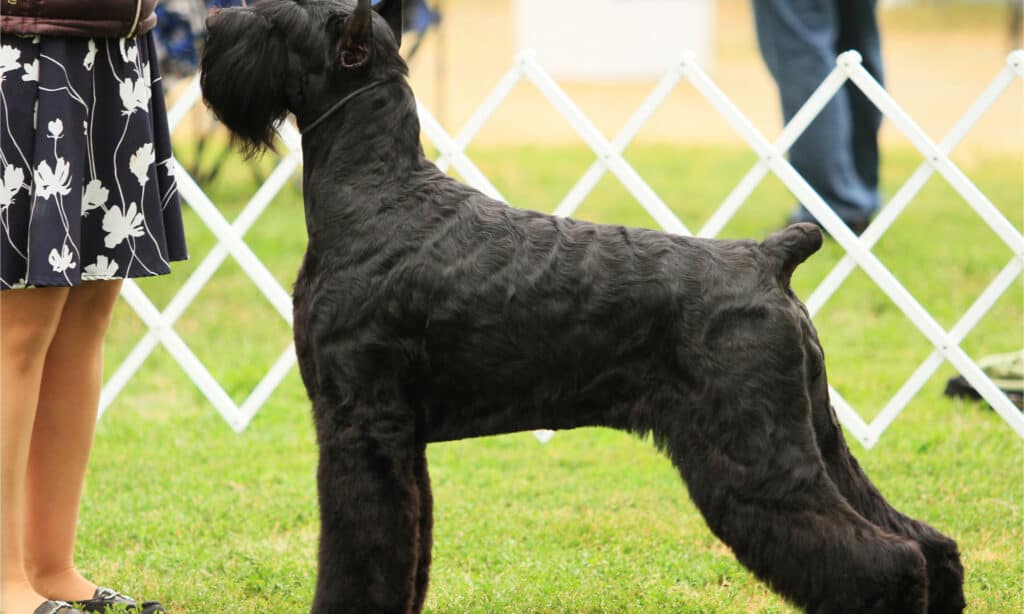
Giant Schnauzers may also need to be groomed by a professional, or their owner will need to learn how to groom them properly to maintain their appearance.
©Canden Scales/Shutterstock.com
Training
Giant Schnauzers are highly intelligent dogs, which can make them easier to train than some other breeds. They have a very protective instinct and need to be taught proper ways to act. They are intended to be working dogs and do their best when they are given a job to do, even if it is something like retrieving a toy. This breed can do very well in agility courses, obedience training, and other dog sports.
Exercise
Giant Schnauzers need lots of activity and do best with owners who live a more active lifestyle. Long walks or hikes, trips to the dog park, or playing with your Giant Schnauzer in a large, fenced-in backyard are examples of ways you can help him get the exercise he needs.
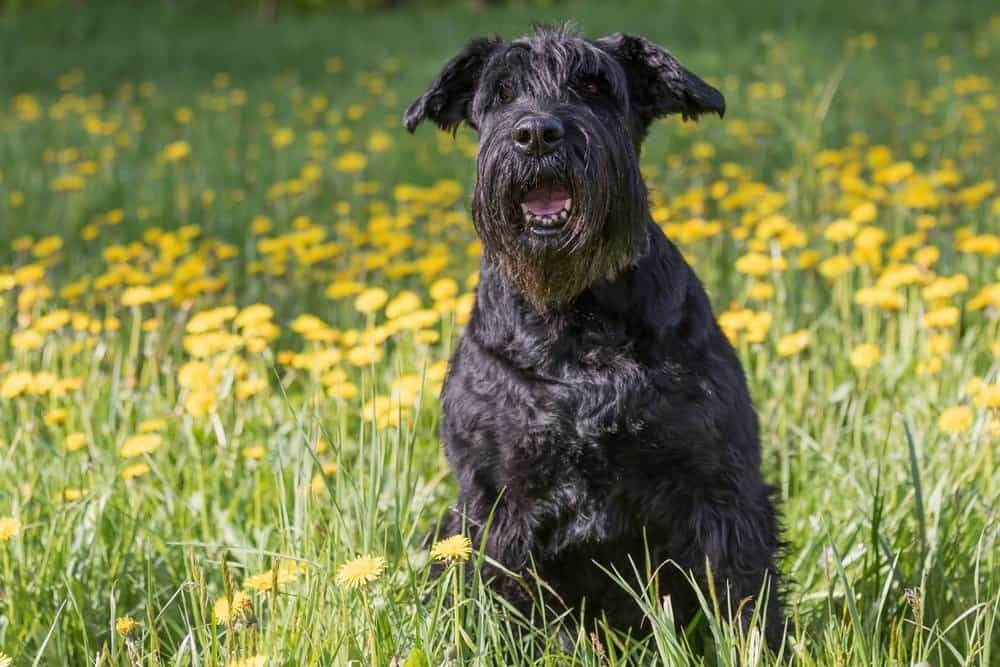
Giant Schnauzers need lots of activity and do best with owners who live a more active lifestyle.
©Frank11/Shutterstock.com
Puppies
Before you bring a Giant Schnauzer home with you, there are a few things you’ll want to do. First, make sure your house it set up and puppy-proof so that it is a safe spot for your puppy to be. You should also select a veterinarian and schedule an appointment to take place very soon after you bring the Giant Schnauzer home. Also, be sure to shop for food, a leash and collar, a dog bed, toys, and other essential supplies you’ll need for a new dog.
Once your new Giant Schnauzer is home, begin training and potty training as soon as possible to get him or her used to expectations. You should also socialize your dog, so they learn how to act around other dogs, people, and places. As puppies, Giant Schnauzers need to eat smaller meals more often throughout the day as well (see the section above on feeding for more information).
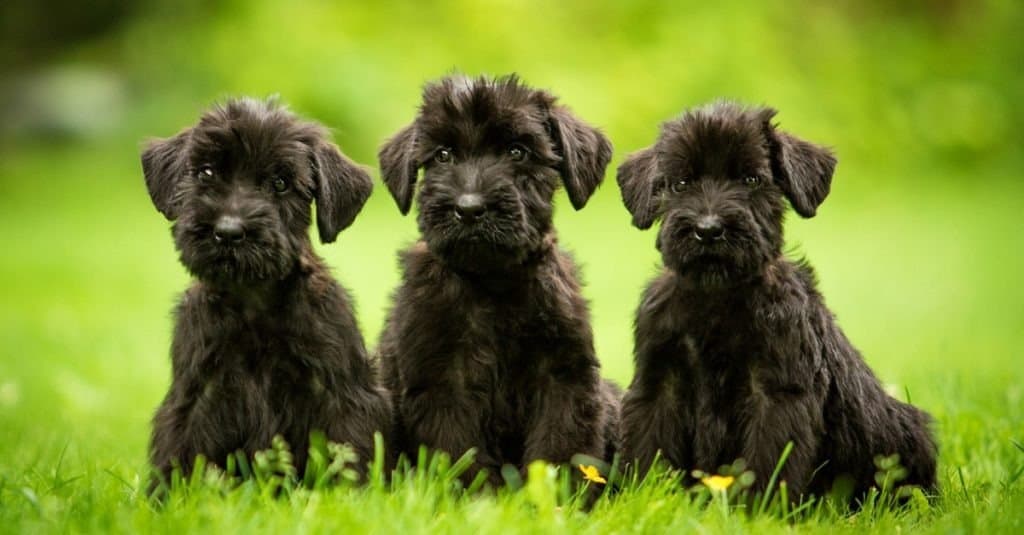
When Giant Schnauzer puppies are three months old, they generally weigh between 21 and 37 pounds.
©Rita_Kochmarjova/Shutterstock.com
With Children
They can be excellent family dogs for families with older children, but a giant schnauzer may not be the best choice for families with young children since they can be a bit too dominant in some cases. Typically, it is recommended that children in a home be 12 or older before bringing home a Giant Schnauzer.
Giant Schnauzers are very loyal dogs. They enjoy spending time and being active with the members of their family.

Typically, it is recommended that children in a home be 12 years old or older before bringing home a Giant Schnauzer.
©Frank11/Shutterstock.com
Similar Dogs
Great Danes, Black Russian Terriers, and Airedale Terriers are three breeds that are similar to the Giant Schnauzer.
- Black Russian Terrier: Giant Schnauzers and Black Russian Terriers are both large working dogs who often have a coat that is black in color. Black Russian Terriers are a bit larger with an average weight of 111.5 compared to the 82.5 average for a male Giant Schnauzer. Both breeds can make a good watchdog. Giant Schnauzers are typically more intelligent and more playful than Black Russian Terriers.
- Great Dane: Great Danes are another working dog like the Giant Schnauzer. Both are very large dogs with high intelligence who originated from Germany. Great Danes can make a better family pet for families with younger children and are also a better choice for senior citizens or for being therapy dogs. While a Giant Schnauzer’s coat is black, a Great Dane’s coat could be fawn, white, brindle, black, blue, or merle in color.
- Airedale Terrier: Airedale Terriers and Giant Schnauzers both have dense and wiry coats and don’t shed too much. Airedale Terriers are smaller than a Giant Schnauzer with an average male weight of 57.5 pounds compared to the 82.5-pound average weight of a male Giant Schnauzer.
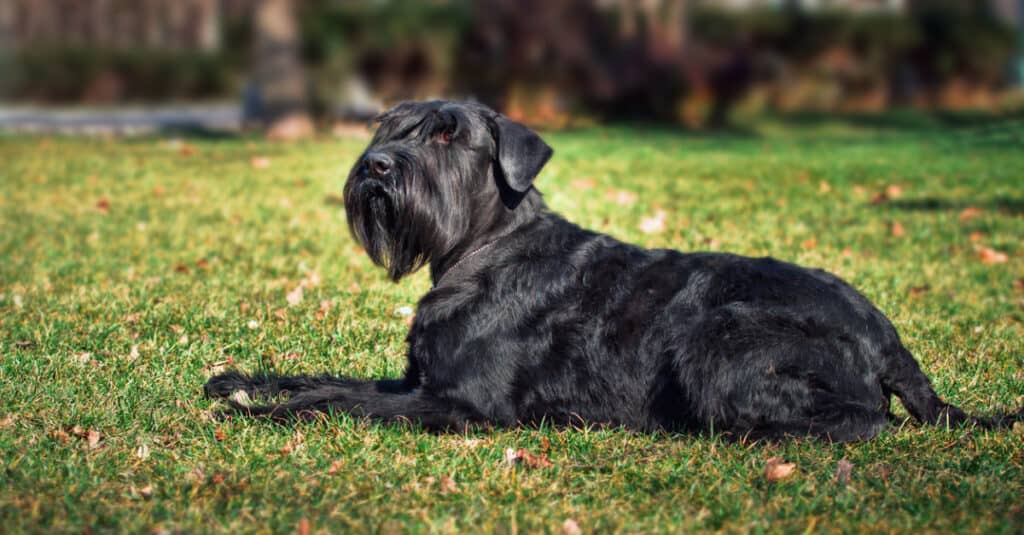
There are similar breeds to the Giant Schnauzer, such as Great Danes, Black Russian Terriers, and Airedale Terriers.
©iStock.com/Voltgroup
Popular Names
If you’re looking for the perfect name for your Giant Schnauzer, read through the list below to find some inspiration.
- Roman
- Boomer
- Bruno
- Magnum
- Max
- Daisy
- Lucy
- Dinah
- Maggie
- Olympas
Giant Schnauzer FAQs (Frequently Asked Questions)
Are Giant Schnauzers herbivores, carnivores, or omnivores?
Giant Schnauzers are Omnivores, meaning they eat both plants and other animals.
What Kingdom do Giant Schnauzers belong to?
Giant Schnauzers belong to the Kingdom Animalia.
What class do Giant Schnauzers belong to?
Giant Schnauzers belong to the class Mammalia.
What phylum to Giant Schnauzers belong to?
Giant Schnauzers belong to the phylum Chordata.
What family do Giant Schnauzers belong to?
Giant Schnauzers belong to the family Canidae.
What order do Giant Schnauzers belong to?
Giant Schnauzers belong to the order Carnivora.
What type of covering do Giant Schnauzers have?
Giant Schnauzers are covered in hair.
What genus do Giant Schnauzers belong to?
Giant Schnauzers belong to the genus Canis.
What is an interesting fact about Giant Schnauzers?
Giant Schnauzers are large, powerful, and dominant!
What is the scientific name for the Giant Schnauzer?
The scientific name for the Giant Schnauzer is Canis lupus.
What is the lifespan of a Giant Schnauzer?
The average lifespan of a Giant Schnauzer is between 12 and 15 years.
How much does Giant Schnauzer cost to own?
The average price to purchase a Giant Schnauzer from breeders is $1,100, however, some breeders may charge as much as $5,000 for a Giant Schnauzer from an excellent breed line. The price to adopt a Giant Schnauzer from a shelter or rescue organization will likely only be a few hundred dollars to cover application fees and vaccinations.
As you budget to purchase a new Giant Schnauzer from one of the breeders in your area or adopt one from a rescue organization, don’t forget about all the prices for all of the other expenses associated with dog ownership. Giant Schnauzers will need regular veterinary care, training, food, and supplies. The first year you own your Giant Schnauzer, you should expect to spend between $500 and $2,000 to cover all of these expenses. Budgeting between $500 and $1,000 for subsequent years of ownership should be sufficient.
Is Giant Schnauzer a good family dog?
Yes, Giant Schnauzers can make a good family dog. However, since they sometimes display more dominant traits, it is often recommended to wait until children are at least 12 years old to bring home a Giant Schnauzer.
How big is a Giant Schnauzer?
Male Giant Schnauzers can weigh between 60 ad 85 pounds and are between 25.5 and 27.5 inches tall. Female Giant Schnauzers weigh between 55 and 75 pounds and are between 23.5 and 25.5 inches tall.
Are Giant Schnauzers dangerous?
While most Giant Schnauzers aren’t dangerous, the breed is very protective. For this reason, some Giant Schnauzers can be more aggressive if they feel their family or home is being threatened. It is important to properly train and socialize a Giant Schnauzer to prevent this possible problem
Are Giant Schnauzers good for first-time owners?
Giant Schnauzers are not always the best choice for a first-time owner. They do better with an experienced owner who is familiar with training the breed. First-time owners looking to adopt a Giant Schnauzer from a rescue organization or purchase one from a breeder need to be dedicated to properly train and socialize their new dog.
What is the difference between a Standard Schnauzer and a Giant Schnauzer?
The main differences between Standard Schnauzer and Giant Schnauzer include their size, adaptability, lifespan, trainability, and health and grooming needs.
What is the difference between Black Russian Terriers and Giant Schnauzers?
The main differences between a Black Russian Terrier and a Giant Schnauzer include their size, coat, behavior, lifestyle, and health issues.
Thank you for reading! Have some feedback for us? Contact the AZ Animals editorial team.
Sources
- American Kennel Club, Available here: https://www.akc.org/dog-breeds/giant-schnauzer/
- Dogtime, Available here: https://dogtime.com/dog-breeds/giant-schnauzer#/slide/1
- Wikipedia, Available here: https://en.wikipedia.org/wiki/Giant_Schnauzer
- Petfinder, Available here: https://www.petfinder.com/dog-breeds/giant-schnauzer/
- Hill's Pet, Available here: https://www.hillspet.com/dog-care/dog-breeds/giant-schnauzer
- Belpatt, Available here: https://en.belpatt.fr/puppy-weight-chart/Giant-Schnauzer?u=lbs#:~:text=Giant%20Schnauzer%20male%3A-,According%20to%20its%20size%2C%20the%20weight%20of%20the%20Giant%20Schnauzer,Schnauzer%20male%20at%201%20year%3F
- The Schnauzer Collective, Available here: https://theschnauzercollective.com/are-giant-schnauzers-dangerous-and-aggressive-key-facts/
- Next Day Pets, Available here: https://www.nextdaypets.com/Schnauzer-Giant.htm#:~:text=You%20should%20budget%20anywhere%20from,Giant%20Schnauzers%20sold%20is%20%241%2C100.
- Animal Care Tips, Available here: https://animalcaretip.com/taking-care-of-young-giant-schnauzers/

